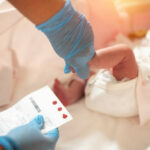Neonatal sepsis is a life-threatening bloodstream infection in newborns, occurring when bacteria, viruses, or fungi invade the baby’s body. It is one of the leading causes of neonatal morbidity and mortality, requiring immediate medical intervention to prevent severe complications.
One of the most critical forms is early-onset neonatal sepsis (EOS), which develops within the first 72 hours after birth and is often caused by bacteria passed from the mother during pregnancy or delivery.

🦠 How Does a Baby Get Early-Onset Sepsis?
During labor and delivery, a baby can come into contact with harmful bacteria from the mother’s birth canal or amniotic fluid. The most common bacteria that cause early-onset sepsis (EOS) include:
🔹 Group B Streptococcus (GBS) – The leading cause of EOS, found in the mother’s vaginal or rectal area.
🔹 Escherichia coli (E. coli) – Often present in the digestive tract and more common in premature babies.
🔹 Listeria monocytogenes – A bacteria from contaminated food that can cross the placenta.
🔹 Other Gram-negative bacteria (e.g., Klebsiella, Enterobacter) – Less common but highly dangerous.
📌 Fact: GBS alone accounts for up to 50% of all early-onset neonatal sepsis cases.
🤰 Risk Factors: When Is a Baby More Likely to Get EOS?
Certain maternal and delivery conditions increase the risk of neonatal sepsis, including:
✔ Maternal GBS colonization (if untreated)
✔ Premature rupture of membranes (PROM) – Water breaks more than 18 hours before delivery
✔ Preterm birth (before 37 weeks) – Weak immune system increases vulnerability
✔ Maternal infection (Chorioamnionitis) – Infection of the placenta and amniotic fluid
✔ Fever during labor (over 38°C/100.4°F)
✔ Meconium-stained amniotic fluid – Can carry bacteria into the baby’s lungs
📌 Fact: Babies born before 34 weeks have a higher risk of EOS due to an underdeveloped immune system.
🩺 Symptoms of Early-Onset Neonatal Sepsis
Symptoms may appear immediately after birth or within the first 24-72 hours and include:
❌ Breathing difficulties (rapid breathing, grunting, apnea)
❌ Low body temperature (hypothermia) or fever
❌ Poor feeding or refusal to eat
❌ Lethargy or extreme irritability
❌ Pale, mottled, or bluish skin (cyanosis)
❌ Low blood pressure (shock in severe cases)
📌 Fact: Symptoms of neonatal sepsis can be subtle and easily mistaken for other newborn conditions. Immediate testing and treatment are critical!
📌 Final Thoughts
Early-onset neonatal sepsis is a serious but preventable condition, often caused by bacteria passed from the mother during pregnancy or delivery. Recognizing the risk factors and symptoms early is key to saving lives.







